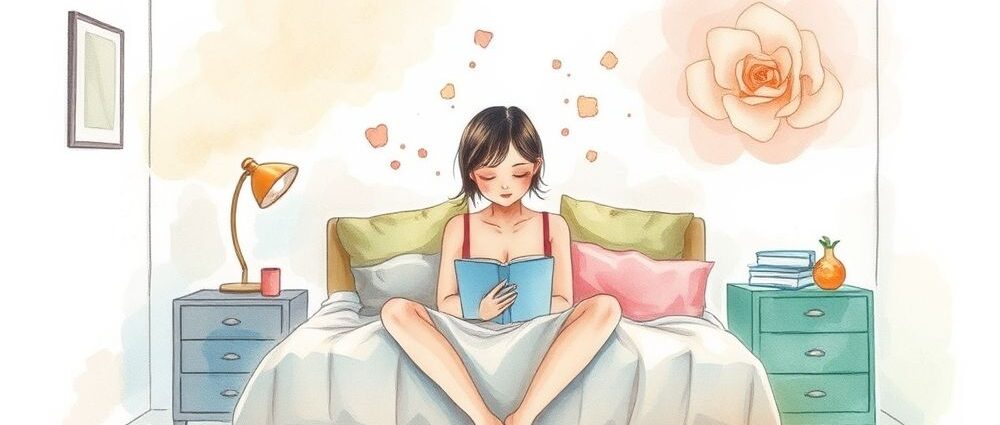Look, I get it. The idea of banishing your phone from the bedroom sounds about as appealing as giving up coffee. But hear me out – because what I’m about to tell you might just change how you think about sleep forever.
You know that feeling when you’re lying in bed, scrolling through your phone, telling yourself you’ll put it down in “just five more minutes”? And then suddenly it’s 1 AM and you have to be up at 6? Yeah, that’s not just a willpower problem. That’s your bedroom working against you instead of for you.
Creating a tech-free bedroom isn’t some wellness trend that’ll disappear next month. It’s actually backed by solid science, and the benefits go way beyond just sleeping better. Think clearer thinking, less morning grogginess, and maybe even saving your relationship from those late-night Instagram rabbit holes.
Actually, scratch that – I’m getting ahead of myself. Let me start with the real problem first.
The Hidden Cost of Electronics in Your Sleep Space
Here’s something that blew my mind when I first learned it: 95% of people use some kind of device within an hour of bedtime. Ninety-five percent! That means almost all of us are basically sabotaging our sleep without even realizing it.
Your bedroom has probably turned into this weird multi-purpose space where you sleep, work, watch Netflix, scroll social media, and oh yeah – try to get some rest. But here’s the thing your brain doesn’t know how to handle: mixed signals.
When your bedroom is full of stimulating stuff, your brain never gets the memo that it’s time to wind down. It’s like trying to meditate in a nightclub. Technically possible, but you’re making it way harder than it needs to be.
How Blue Light Messes With Your Sleep Hormones
I used to think the blue light thing was overblown. Like, how much difference could a little light from a screen really make? Turns out – a lot more than I expected.
Blue light tricks your brain into thinking it’s still daytime. When that happens, your body basically hits the brakes on producing melatonin, which is that drowsy hormone that makes you feel sleepy. Without enough melatonin, you’re stuck in this weird limbo where you’re tired but wired.
Studies comparing people who read paper books versus tablets before bed found something pretty crazy. The tablet users produced way less melatonin, took longer to fall asleep, had shorter REM cycles, and felt more tired the next day. All from what seemed like harmless bedtime reading.
And teens? They’re even more sensitive to blue light than adults. So if you have kids who are constantly on their phones before bed and then dragging themselves out of bed in the morning, this might be why.
The Stress Factor Nobody Talks About
But blue light is just part of the story. There’s this whole other layer that most people miss – the mental stimulation piece.
Think about what you’re actually doing on your phone before bed. Checking work emails that stress you out. Scrolling through social media and comparing your life to everyone else’s highlight reel. Reading news that makes you angry or anxious. Watching videos that get your brain all fired up.
None of that exactly screams “peaceful sleep preparation,” does it?
A study of nearly 2,000 workers found that checking email late at night was one of the most stressful habits people had. Even if the email wasn’t urgent, it snapped people back into work mode right when they should be transitioning to rest mode.
What Science Actually Says About Tech-Free Bedroom
The research on bedroom technology keeps piling up, and honestly, it’s not looking good for Team Electronics.
A massive study of over 10,000 adults found that 95% had smartphones in their bedrooms, and 80% used them regularly at bedtime. The results? Higher rates of poor sleep quality, excessive daytime sleepiness, and all the health problems that come with chronic sleep deprivation.
But here’s what really caught my attention: only 4% of people had completely device-free bedrooms. Four percent! That means 96% of us are sleeping surrounded by some kind of technology.
The Melatonin Studies That Will Shock You
Harvard researchers did this experiment where they exposed people to blue light versus green light for 6.5 hours. The blue light suppressed melatonin for twice as long and shifted people’s circadian rhythms by three hours instead of 1.5 hours.
Three hours. That’s like your body thinking it’s 9 PM when it’s actually midnight.
Other studies have shown that even dim light – just 8 lux, which is about twice as bright as a nightlight – can mess with your melatonin production. Your smartphone at night? That’s pumping out way more light than that.
Sleep Procrastination Is Real (And Getting Worse)
Ever heard of bedtime procrastination? It’s when you delay going to sleep even though you know you should, and there’s nothing actually preventing you from sleeping.
Sound familiar?
Social media and endless streaming content make this so much worse. There’s always one more video, one more post, one more episode. Before you know it, you’ve stolen hours from your own sleep without getting anything meaningful in return.
Research shows this kind of sleep procrastination is linked to stress, poor self-control, and – get this – using electronic devices in bed. It’s like a perfect storm of sleep sabotage.
The Real Benefits of Going Tech-Free Bedroom
Alright, enough doom and gloom. Let’s talk about what actually happens when you create a tech-free bedroom. And I’m not talking about some magical transformation overnight – though some people do notice changes pretty quickly.
Better Sleep Quality (Obviously)
This one’s probably not surprising, but the extent of it might be. People who keep electronics out of their bedrooms fall asleep faster, sleep more deeply, and wake up feeling more rested.
But it’s not just about quantity. The quality improves too. You get more of that deep, restorative sleep your body actually needs to repair itself and consolidate memories.
Some people report that after a few weeks of tech-free sleeping, they naturally start waking up around the same time without an alarm. Your body’s internal clock gets a chance to work properly again.
Less Anxiety and Mental Chatter
Here’s something I didn’t expect: removing technology from the bedroom helps quiet that mental chatter that keeps you awake.
You know how sometimes you lie in bed and your brain just won’t shut up? It’s running through tomorrow’s to-do list, replaying conversations, worrying about things you can’t control right now anyway.
A lot of that mental noise comes from overstimulation throughout the day, especially right before bed. When you create a calm, tech-free bedroom environment, your brain actually gets a chance to start winding down.
Improved Morning Energy
This was the biggest surprise for me personally. I thought I was just a “not a morning person” type of person. Turns out, I was just chronically sleep-deprived from late-night phone scrolling.
When you’re getting genuinely restorative sleep, mornings become… well, not terrible. You wake up feeling more alert, less groggy, and you don’t need to mainline caffeine just to function.
Stronger Relationships
Okay, this might sound cheesy, but stay with me. When you’re not both lying in bed staring at your phones, you actually talk to each other. Revolutionary concept, right?
Couples who create tech-free bedrooms often report feeling more connected. They have actual conversations, maybe read together, or just enjoy being present with each other without digital distractions.
And if you have kids, modeling healthy sleep habits makes a huge difference in their sleep quality too.
How to Actually Create Your Tech-Free Bedroom
Enough theory. Let’s get practical. Creating a tech-free bedroom doesn’t have to be an all-or-nothing overnight transformation. You can ease into it and find what works for your situation.
The Device Audit – What Needs to Go
First, take inventory of what’s actually in your bedroom. I’m talking everything electronic:
Your phone (obviously), tablet, laptop, TV, smart speakers, fitness trackers, e-readers, gaming devices, even things like digital photo frames or smart home controls.
Don’t panic – you don’t necessarily have to get rid of all of it immediately. But you need to know what you’re working with.
Start with the most problematic stuff first. That phone that’s constantly buzzing with notifications? That’s priority number one. The TV that you fall asleep to every night? Also high on the list.
Setting Up Your Charging Station Outside
One of the biggest barriers people face is losing their bedside charging setup. The solution? Create a charging station somewhere else in your home.
Pick a spot in your living room, kitchen, or hallway where you can set up a charging station for all your devices. Get a multi-port charger or power strip, maybe a small basket or tray to keep everything organized.
The key is making this convenient enough that you’ll actually use it. If it’s a hassle to charge your devices outside the bedroom, you’ll end up bringing them back.
Creating New Bedtime Habits
This is where most people struggle. You’ve been using your phone as your bedtime entertainment for years. What are you supposed to do instead?
The good news is there are lots of options that actually help you sleep better:
Read an actual book (I know, weird concept). Keep a few books you’re excited about on your nightstand so you always have options.
Try journaling or gratitude practice. Just five minutes of writing down thoughts or things you’re grateful for can help quiet your mind.
Practice simple breathing exercises or progressive muscle relaxation. These actually activate your body’s relaxation response.
Listen to calming music, nature sounds, or meditation apps – but use a speaker, not earbuds, and set a timer so they turn off automatically.
Dealing With the Practical Stuff
I know what you’re thinking. This all sounds nice in theory, but what about real life? What about work emergencies? What if you need your phone for safety? Let’s address the practical concerns.
What About Your Alarm Clock?
This is usually the first question people ask. Easy solution: get an actual alarm clock. I know it feels weirdly retro, but they still make them.
Look for one with a gentle wake-up light that gradually brightens, or soothing sounds instead of jarring beeps. Some have features like white noise or nature sounds that can actually help you sleep better.
If you’re worried about oversleeping, get one with battery backup so power outages won’t mess you up. Place it across the room so you have to get out of bed to turn it off.
Handling Work Emergencies and FOMO
Here’s the truth: most “emergencies” aren’t actually emergencies. They’re just things that feel urgent because we’ve trained ourselves to respond immediately to every notification.
Set boundaries with colleagues and family about when you’re available. Let them know you’re not reachable between certain hours unless it’s a genuine emergency.
For true emergencies, you can keep your phone outside the bedroom but close enough that you’d hear a call if someone really needed to reach you. Most phones let you set up emergency contacts that can bypass do-not-disturb settings.
As for FOMO – that fear of missing out – ask yourself honestly: what are you actually afraid of missing? A social media post? A news story? Something that’ll still be there in the morning?
Getting Your Partner on Board
This can be tricky if your partner isn’t immediately sold on the idea. Don’t try to force it. Instead, lead by example and share what you’re learning.
Maybe start by agreeing to one tech-free hour before bed. Or alternate – one night they can use their phone, the next night they join you in going device-free.
Focus on the benefits you’re experiencing rather than lecturing about what they should do. When they see you sleeping better and feeling more energetic, they might get curious.
Making Tech-Free Bedroom Stick – The Transition Period
Let’s be real – the first week or two might feel weird. You’re breaking habits that have been years in the making. Your brain might feel restless without its usual bedtime stimulation.
Week One Survival Guide
Expect some resistance, both from yourself and from your sleep patterns. You might lie awake for a few extra minutes at first while your body adjusts to the new routine.
Have your replacement activities ready to go. Books, journals, calm music – whatever you’ve chosen to replace screen time. Keep them easily accessible so you’re not tempted to reach for your phone out of boredom.
Don’t give up if it doesn’t feel natural immediately. Like any habit change, it takes time for your brain to adapt to the new pattern.
Replacing Screen Time With Better Activities
The key is finding replacement activities that are genuinely relaxing, not just less stimulating than screens.
Reading fiction can be great because it engages your imagination without overstimulating your brain. Avoid anything too thrilling or thought-provoking right before sleep.
Gentle stretching or yoga can help release physical tension from the day. Even just a few minutes of simple stretches can signal to your body that it’s time to relax.
Meditation doesn’t have to be complicated. Even just focusing on your breathing for five minutes can help quiet mental chatter.
Some people love adult coloring books, crossword puzzles, or other quiet activities that occupy the hands and mind without being too stimulating.
Common Mistakes to Avoid
After talking to lots of people who’ve tried creating tech-free bedrooms, I’ve noticed some patterns in what works and what doesn’t.
Don’t go completely cold turkey if you’re a heavy device user. The shock to your system might make you give up entirely. Instead, gradually reduce usage over a week or two.
Don’t rely on willpower alone. If your phone is right there on the nightstand, you’ll probably grab it eventually. Make it physically inconvenient to use devices in bed.
Don’t forget about partner devices. If your partner is still scrolling in bed next to you, that light and mental energy will affect your sleep too.
Don’t ignore the charging logistics. If you make it hard to charge your devices outside the bedroom, you’ll end up bringing them back.
Don’t expect perfection immediately. There will probably be nights when you slip back into old patterns. That’s normal – just get back on track the next night.
Quick Takeaways
Your bedroom should be a sleep sanctuary, not an entertainment center. The science is clear that electronics interfere with both sleep quality and quantity.
Blue light suppresses melatonin production, making it harder to fall asleep and reducing sleep quality. But the mental stimulation from device usage is equally problematic.
Creating a tech-free bedroom improves not just sleep, but morning energy, anxiety levels, and relationship quality.
Start with small changes rather than trying to transform everything overnight. Set up a charging station outside the bedroom and gradually transition to new bedtime habits.
Practical concerns like alarms and emergencies have simple solutions that don’t require keeping devices in the bedroom.
The transition period might feel uncomfortable at first, but most people notice improvements within a week or two.
Remember that this isn’t about being perfect – it’s about creating an environment that supports better rest and overall wellbeing.
Wrapping Up
Here’s what I’ve learned after helping hundreds of people transition to tech-free bedrooms: it’s not really about the technology. It’s about reclaiming your sleep and, honestly, reclaiming a bit of your life.
When you stop scrolling before bed, you don’t just sleep better. You start your days feeling more human. You’re more present with the people you care about. You break that cycle of constant stimulation and give your brain a chance to actually rest.
Is it easy? Not always. Our devices are designed to be addictive, and breaking that habit takes some intention. But is it worth it? Ask me again after you’ve had your first full week of truly restorative sleep.
Your bedroom should be your sanctuary, not another office or entertainment center. When you make that shift – when you prioritize rest over stimulation – everything else starts to fall into place.
Sweet dreams are made of… well, not scrolling until 2 AM, that’s for sure.
FAQs
What if I need my phone for emergencies? Keep it outside the bedroom but within earshot. Most phones allow emergency contacts to bypass do-not-disturb settings, so true emergencies can still reach you.
How do I wake up without my phone alarm? Invest in a dedicated alarm clock. Look for ones with gradual wake-up lights or gentle sounds. Place it across the room so you have to get up to turn it off.
What if my partner won’t give up their devices? Start with yourself and lead by example. You might agree to one tech-free hour before bed or alternate nights. Don’t force it – focus on the benefits you’re experiencing.
Is it okay to use an e-reader in bed? E-ink readers like basic Kindles are better than tablets or phones since they don’t emit blue light. But even these can be mentally stimulating, so use them earlier in your bedtime routine rather than right before sleep.
What should I do instead of scrolling before bed? Try reading fiction, gentle stretching, journaling, listening to calming music, or simple breathing exercises. The key is finding activities that relax rather than stimulate your mind.
How long does it take to adjust to a tech-free bedroom? Most people notice some improvements within the first week, with more significant changes after 2-3 weeks. Your sleep patterns need time to adjust to the new routine.
What about using my phone for meditation apps? Use a speaker or smart display outside the bedroom, or try meditation techniques that don’t require devices. Many effective relaxation methods – like focused breathing – don’t need any technology at all.



